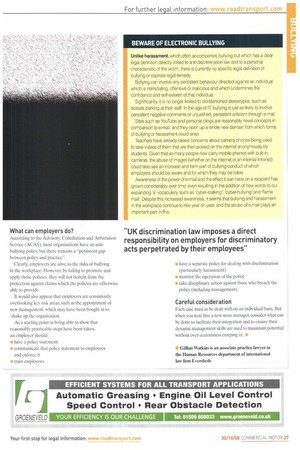BEWARE OF ELECTRONIC BULLYING
Page 27

If you've noticed an error in this article please click here to report it so we can fix it.
Unlike harassment, which often accompanies burying but which has a clear legal definition directly linked to anti-discrimination law and to a personal characteristic of the victim, there is currently no specific legal definition of bullying or express legal remedy.
Bullying can involve any persistent behaviour directed against an individual which is intimidating, offensive or malicious and which undermines the confidence and self-esteem of that individual.
Significantly, it is no longer limited to old-fashioned stereotypes, such as bosses barking at their staff. In the age of IT, bullying is just as likely to involve persistent negative comments or unjustified, persistent criticism through e-mail.
Sites such as YouTube and personal blogs are reasonably novel concepts in comparison to e-mail, and they open up a whole new domain from which forms of bullying or harassment could arise.
Teachers have already raised concerns about camera phones being used to take videos of them that are then posted on the internet anonymously by students. Given that so many people now carry mobile phones with built-in cameras, the abuse of images (whether on the internet or an internal intranet) could also see an increase and form part of bullying conduct of which employers should be aware and for which they may be liable.
Awareness of the power of e-mail and the effect it can have on a recipient has grown considerably over time, even resulting in the addition of new words to our expanding 'e' vocabulary, such as 'cyber-stalking', 'cyber-bullying' and 'flame mail'. Despite this increased awareness, it seems that bullying and harassment in the workplace continue to rise year on year, and the abuse of e-mail plays an important part in this.




































































































































































